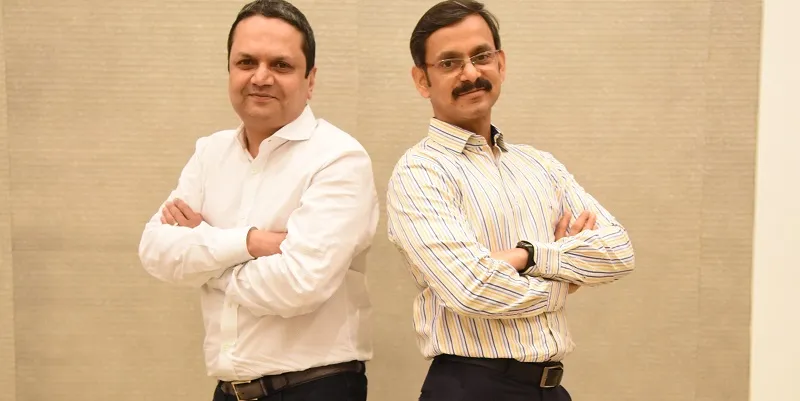How [24]7.ai reinvented itself from a small BPO to a $400 million company
The story of P V Kannan and Shanmugam Nagarajan, Founders of [24]7.ai, is all about timing it right and staying on top. They have survived the storm of change that began in the business process outsourcing business
When everyone was getting ready to welcome 2018, the Co-founder of [24]7.ai, Shanmugam Nagaran, was travelling to the US to meet several startups and clients. Soon after, he made a trip to Australia and returned home just in time before the new year kicked in.
There are many things that have to begin ahead of time in order to be future ready. Step into the office of Shanmugam’s company and you would be surprised that it was once a place where human voice played a major role in customer service.
Today, there are engineers working on chatbots and voice-based APIs. Natural language processing, Machine Learning, and AI are not just buzzwords in the office anymore. There is a 700-member data analytics team which scores customer interaction and uses machines to solve customer queries, answering only those that do not get addressed by machines.
“Machine learning and artificial intelligence are here to stay. Customer service is heading that way and clients want to better customer service with a man and machine interface,” says Shanmugam.
Today, 95 percent of the queries do not need human beings. “The future is a combination of data science and fast computing to help companies connect with their customers better,” says Shanmugam. The company now handles 40 million chats and 1.5 billion conversations per year. It is experimenting with every virtual (voice and text) assistant based APIs that have been released over the last three years. It has also tied up with a few well-known global tech companies, such as Microsoft, to use their deep learning platform for natural language processing on the [24]7.ai platform.

The story of P V Kannan and Shanmugam Nagarajan, Founders of [24]7.ai, is all about timing it right and staying on top. They have survived the storm of change that began in the business process outsourcing business — as voice-based revenues began to drop in early 2012, globally, they embraced a technology-oriented approach towards customer service.
In the beginning
In the eighties, Shanmugam was studying MCA in Coimbatore, and he considers himself lucky to have been hired by TCS. It all happened when he was still a student and volunteering for the Computer Society of India. “I suggested to my former employer, at the event, that companies should also employ MCA students. I never thought they would come back next year and offer me a job,” says Shanmugam. Similarly, Kannan had passed the Chartered Accountancy exam and was employed by TCS. Both of them became friends there, and in 1992, they left for the US to pursue new opportunities. That’s where the startup bug bit them and they founded a company called Business Evolution — it built collaboration tools for business, which enabled them to access content to train employees to access mails. They had IBM using their tool, and eventually, the product was sold in 1999. This gave the duo an opportunity to think ahead for the future, and at the time, call centre offshoring had taken off in India. “We had already built collaboration tools; we understood how it worked and we began to think about using India as a centre to serve the world,” says Shanmugam.
While in India they met B V Naidu, the ex-director of the newly formed Software Technology Park of India, who convinced them to set up a call centre in Bengaluru. This was the year 2000 and [24]7.ai was born. Alta Vista was their first client and they handled close to 100 queries a day. They started with a seed capital of $2 million. By the end of the decade, they had crossed 100 million in revenues. But 2010 onwards, they began to invest in the future.
“The IT industry has to reinvent itself and stay up to date with new technologies. But, back then companies had a different model, which was services that were very dependent on IT skills relevant to that time, like application development and testing, BPO services for clients. Today everyone has to invest in AI and machine learning as clients are demanding IT to be relevant to business,” says Mohandas Pai, MD of Aarin Capital.
Being future ready
Being future ready means investing in the future without destroying the values of the past. It’s a slow process. You know you are ready because you have invested time and effort for changes and for a new future. That’s what the journey of [24]7.ai has looked like. “It all began because we could automate the knowledge of the past and repurpose our folks to build products,” says Shanmugam. The company spends 10 percent of its revenues on R&D. When you walk into the office, you get to see a lot of AI-based work and internal hackathons. One can only imagine how it transformed itself from old school BPO to a tech company that serves customer engagement.
It began in 2012 with a tie up with Microsoft for natural language processing. Microsoft claims that its deep neural network improves recognition of native speakers and for non-native English speakers by up to 26 percent over traditional solutions. [24]7.ai says it has allowed its clients to save $80 million annually in costs.

The company has leapfrogged by making several acquisitions and acqui-hires. It made five acquisitions since 2012. The companies it acquired were Voxify (call automation tech), Shopalize (social commerce), Intelliresponse (digital self-service), and Campanja (search engine bidding platform). With all these technologies combined with its data analytics, here is how it is serving its clients on customer engagement.
- Customer Journey Analytics: A SaaS solution which tracks how customers interact with companies. It gives companies measurable data and insights.
- Digital Marketing: Its machine learning system combines retargeting and predictive targeting to deliver ads for better engagement with customers. Its predictive search optimises campaign performance and delivers personalised customer journeys.
- Its AI-powered agent works across speech (IVR) and chatbot channels (voice and text) to serve customers.
- Active Share: A visual experience platform where a caller and agent can interact during a call.
- Chat: The smart chat platform combines predictive models, intelligence, to help sales and customer service companies make their conversations effective.
- Digital Chat Agents: This is a combination of machine and human interfaces to make experiences better.
- AI platform: Combines data to find out intent and makes services highly relevant if you call a company that [24]7.ai serves.
Some of its clients include Hilton, AT&T, Citi, Best Buy, American Express, eBay, and Farmers Insurance. 75 percent of its revenues come from the US and the rest comes from the South Asian and Australian region.
The company has bet on the right things by offering an end-to-end suite for personalisation.
"The market for VPA-enabled wireless speakers, such as the Amazon Echo devices and Google Home, is expanding rapidly with more vendors, device types and use cases," says Werner Goertz, Research Director at Gartner.
Although the VPA speaker is currently thought of as a consumer device, from 2019, starting with the hospitality and remote healthcare industries, enterprise adoption will drive further market growth through a fragmented portfolio of specialist devices.
"In healthcare, remote diagnostics and elder care applications will be enabled by VPA speakers. The cost of hardware and services will, at least in part, be subsidised by healthcare ecosystem partners who are likely to gain substantial efficiencies, and encourage patient adoption," says Ranjit Atwal, Research Director at Gartner. "New self-service, voice-based shopping and payment experiences will be enabled, reducing friction in the bricks-and-mortar as well as e-commerce shopping environments."
Beginning in 2019, third-generation VPA speaker products will start shipping with some artificial intelligence (AI) functions running on the device rather than in the cloud. Gartner expects these AI-enabled VPA speakers to use edge-device, machine-learning capabilities to enhance latency, alleviate privacy/security issues, and utilise bandwidth more efficiently.
So, while enterprises make this bet, they also want to learn from consumers and this is exactly where Kannan and Shanmugam’s company steps in. It will have competition from Infosys BPO, Genpact, Wipro BPO, and HGS Global. The traditional voice-based per seat business model is passé and the future is in client engagements that are a combination of quick outcomes of projects and long-term contracts. No wonder the traditional voice business is only 15 percent of the company’s revenues. In fact, Indian BPO companies have no choice but to become technology companies and [24]7.ai has certainly morphed itself into becoming a strong player in the customer engagement and analytics space.


![How [24]7.ai reinvented itself from a small BPO to a $400 million company](https://images.yourstory.com/cs/wordpress/2018/01/PV-and-Nags_logo_standing-2.jpg?mode=crop&crop=faces&ar=2%3A1&format=auto&w=1920&q=75)




